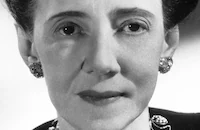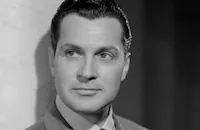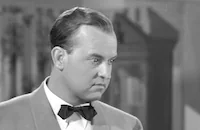The Story of Temple Drake

Brief Synopsis
Cast & Crew
Stephen Roberts
Miriam Hopkins
William Gargan
Jack La Rue
Florence Eldridge
Sir Guy Standing
Film Details
Technical Specs

Synopsis
Temple Drake, the daughter of a judge in a Southern city, refuses to marry steady, reliable lawyer Stephen Benbow, whom she loves, because she has a wild streak, which has led to her reputation as a woman who will tease men, but will not sleep with them. The night of a town dance, Temple again turns down Stephen's proposal and goes out for a ride with one of her suitors, Toddy Gowan, who has been drinking. Their car crashes near a delapidated plantation mansion that is being used as a speakeasy by bootlegger Lee Goodwin. A menacing bootlegger who is called Trigger because he is loose with his gun, forces the couple into the house in the middle of a thunderstorm. Toddy, still terribly drunk and suffering from a head wound, makes an attempt to defend Temple against a lewd bootlegger, but he knocks Toddy out and Lee defends her. She then tries to escape, but Trigger insists she stay in the house. Lee's lower class wife, Ruby Lemarr, who lives in the house with her baby, suggests Temple sleep in the barn, where she will be safe. Tommy, a young half-wit, stands guard at the barn door with his rifle to protect Temple, but at dawn, when the men return from their liquor run, Trigger shoots Tommy dead and rapes Temple in the hay. Trigger then takes Temple to a house of ill-repute in the city run by a woman named Reba, and makes Temple his moll. Toddy, after waking to find himself in a Dixon warehouse the night following the storm, skips town. The newspapers, meanwhile, report that Temple is visiting relatives in Pennsylvania. Lee is arrested for Tommy's murder and Stephen is appointed as his lawyer, but Lee refuses to indict Trigger after nearly being killed by a bullet in his cell. Ruby mentions the name Trigger and tells Stephen to look for him at Reba's place. When Stephen enters Trigger's room, he finds Temple dressed in a negligee and nearly attacks Trigger, but Temple, sure Trigger is about to shoot Stephen, tells him that she is with Trigger of her own accord. Believing the lie, Stephen serves Trigger and Temple summonses for Lee's trial and leaves. Temple then tries to escape, but Trigger lunges at her and, to keep herself from being raped again, Temple shoots him dead. Temple then returns to Dixon, and when Lee's trial is almost over, she begs Stephen not to make her testify and tells him she killed Trigger. In court, against the judge's warnings not to disgrace his daughter, Stephen puts Temple on the stand, but, out of love for her, is unable to interrogate her about Trigger. Temple, however, suddenly confesses all that has happened to her, including being witness to Tommy's murder, being raped, and finally killing Trigger. She then faints, and Stephen, proud of her for aiding justice, carries her from the courtroom.

Director
Stephen Roberts
Cast

Miriam Hopkins

William Gargan

Jack La Rue

Florence Eldridge
Sir Guy Standing

Irving Pichel
Jobyna Howland
William Collier Jr.

Elizabeth Patterson
James Eagles
Harlan E. Knight

Louise Beavers
Arthur Belasco
Henry Hall
Clarence Sherwood
Oscar Apfel

Kent Taylor
Harold Goodwin
Clem Beauchamp

Grady Sutton
George Pearce

Hattie Mcdaniel
Crew

Photo Collections
Videos
Movie Clip



Hosted Intro
Film Details
Technical Specs

Articles
The Story of Temple Drake
The Story of Temple Drake, produced in 1933 (at the height of Pre-Code sophistication and confidence), is one of the most daring and disturbing of these films. Mick LaSalle, in his book Complicated Women: Sex and Power in Pre-Code Hollywood, describes the film as "humid with sex, a sense of animal-like motives beneath the surface." Based on William Faulkner's notorious novel Sanctuary (first published in 1931), it stars Miriam Hopkins as Temple Drake, the wild child granddaughter of a moralistic old judge (Sir Guy Standing) blind to her good time lifestyle and her attraction to reckless bad boys. He still harbors fantasies that nice boy Stephen (William Gargan), an idealistic attorney who defends indigent clients pro-bono, will one day marry Temple and calm her restless nature, but Temple has other ideas. Her impulsive, self-destructive nature lands her in the back-road hideout of hillbilly bootleggers and their big city gangster partner, a sneering, savage thug accurately named Trigger (Jack La Rue).
Bad girls go to hell in so many of these movies but Temple isn't bad so much as rebellious and "loose," a pleasure-seeking young woman who defies convention. She just wants to have fun and ends up a prisoner of the most depraved gang this side of a seventies drive-in thriller. "Hopkins first plays Temple as a flighty girl, and rather than transform her into someone noble, Hopkins assures us of her flawed character throughout," observes LaSalle. True to the genre, Miriam Hopkins strips off her wet gown to her skimpy silk skivvies, but this isn't some playful bit of cheesecake. She's literally stripped of her defenses and at the mercy of men who take their turns leering and then fight over her like dogs over a piece of meat; she's safe until the fighting stops and the top dog goes in to take his spoils.
Some of the elements of Faulkner's novel had to be toned down for the screen, yet what remains is still extreme even by the standards of the most adult Pre-Code movies. Unable to show the violence or the violations explicitly, director Stephen Roberts brings the camera in for uncomfortably intimate close-ups, surreptitiously putting us into point-of-view of both Temple and Trigger as he marches into her personal space and, as she screams and the screen fades to black, overpowers her. It's the start of an ordeal that includes rape, murder, prostitution, and systematic degradation. None of it is shown onscreen, of course, but the implications are unmistakable, as is the state of shock that comes over the once bubbly, lively Temple like a shadow of shame and pain. "Hopkins doesn't play the usual emotions, nor does she ask for sympathy," explains LaSalle. "She plays Temple merely as terrified, morally clueless, and odd. We watch her senses overload, then shut off."
Jack La Rue came to Hollywood by way of Broadway, leaving a successful career to test for the lead in Howard Hawks' Scarface (1932). Though he lost the role to Paul Muni, he stayed in Hollywood and carved out a career playing thugs and gangsters, often with a seductive and dangerous edge. Trigger was his most darkly menacing role and, along with the lead in the 1948 British noir thriller No Orchids for Miss Blandish (another crime thriller that pushed the envelope of sex in the cinema), his most memorable screen appearance.
The Story of Temple Drake was released in 1933, just before Joseph Breen and the new Production Code Administration arrived with the power to censor Hollywood films. When the Code went full force the next year, The Story of Temple Drake and many other films were pulled from the screens rather than submit to drastic cuts or reshoots. And while periodically revived in festivals of Pre-Code movies, it has been more difficult to see than many of the less daring but more famous Pre-Code films of its time. It has yet to be rediscovered by many fans of the era.
Miriam Hopkins was a guest at a screening of The Story of Temple Drake at the Museum of Modern Art in 1972. According to LaSalle, after the screening, the sixty-nine-year-old star quipped to the women in line for the ladies' room: "Ya'll suffered through this but I suffered most. I think I should be allowed to go in first." Even in retirement, Hopkins had sassy style. She passed away later that year.
Producer: Benjamin Glazer
Director: Stephen Roberts
Screenplay: Oliver H.P. Garrett (screenplay); William Faulkner (novel "Sanctuary"); Maurine Dallas Watkins (uncredited)
Cinematography: Karl Struss
Music: Karl Hajos, Bernhard Kaun (both uncredited)
Cast: Miriam Hopkins (Temple Drake), William Gargan (Stephen Benbow), Jack La Rue (Trigger), Florence Eldridge (Ruby Lemarr), Sir Guy Standing (Judge Drake), Irving Pichel (Lee Goodwin), Jobyna Howland (Miss Reba), William Collier, Jr. (Toddy Gowan), Elizabeth Patterson (Aunt Jennie), James Eagles (Tommy).
BW-72m. Closed Captioning.
by Sean Axmaker
Sources: "Complicated Women: Sex and Power in Pre-Code Hollywood," Mick LaSalle. Thomas Dunne Books, 2000. IMDb

The Story of Temple Drake
Quotes
Why do you keep the baby in the wood box?- Temple Drake
So the rats don't get it.- Ruby Lemar
That Mr. Judge would sure know more about his daughter if he did her laundry!- Maid
Trivia
Was extremely controversial because of its content matter. It was banned in Pennsylvania and Ohio, and Joe Breen ordered the film to never be re-released again once the Production Code came into effect in mid-1934. The film did not resurface until the mid-1950s.
Notes
For a short period before this film went into production, it was called The Shame of Temple Drake. George Raft was suspended by Paramount for his refusal to appear as "Trigger" in this film, but returned to the studio for the 1934 film The Trumpet Blows. According to information found in the MPPDA file on the film, prior to shooting, the Hays Office objected to any filmed adaptation of William Faulkner's novel, and later forbade any reference to the novel in advertising for the film. Joseph I. Breen, in charge of public relations for the Hays Office, admitted in a memo dated March 17, 1933 that he had not read the novel but was convinced that people would say that the filmmakers had adapted for the screen "the vilest book of the present years." It was Breen's opinion, however, that the picture was so tame in comparison to the novel that readers of the book who saw the picture would "charge us with fraud."
On March 9, 1933, P. S. Harrison, editor of Harrrison's Reports, wrote a letter to Adolph Zukor chastising him for making this film. Zukor had made the claim that Hays agent James Wingate, formerly Chairman of the New York Censorship Board, had approved the script. In the letter, Harrison argued that, despite Wingate's former position, he "does not possess purgatorial powers" and was guilty of passing pictures which "millions of American citizens considered demoralizing." Harrison went on to say that is was unfair to exhibitors who are bound by contract to distribute Paramount films to be forced to act against "their own conscience and moral upbringing." "Don't you realize," Harrison continued, "the harm that you will do to this nation, not to mention the industry, by putting this book into a picture?" Harrison further pointed out George Raft's refusal to appear in the picture, questioning Zukor's reasoning that Raft turned down the part not because he objected to the material, but because he wanted more money.
On March 20, 1933, the Hays Office gave Paramount a list of recommended cuts. The two so-called "danger scenes" were the scenes at Miss Reba's "house" and the rape scene, which originally took place in a corn crib. [In Faulkner's novel, a corncob rape takes place.] On 16 Mar, Zukor received a letter from the Hays Office warning him against including shots in which a corncob is picked up and looked at following the scene of the rape. The shots were allegedly meant to be shown only in the rushes and not in the final release, but, after viewing the shots, the Hays Office forced Paramount to change the location of the rape to a barn instead of a corn crib, and no shots in which corncobs were shown and no references to the corn crib or corncobs were allowed. In May, the Hays Office tried to remove a phallic symbol from the Fox film The Warrior's Husband (see below), which was left in the preview, and Paramount producer Emanuel Cohen reportedly backed that effort because he had been forced to remove the phallic symbol from this film. Regarding Miss Reba's place, the Hays Office felt that the location was "portrayed too graphically as a house of assignation." The line itself referring to the brothel as "Miss Reba's place" was objected to, and a pan of a hat rack filled with men's hats was cut as well as Miss Reba's line, "I got some of the biggest people in town right here in this house spending their money like water," and the line, "Just got back from church myself." Reba's use of the word "chippie" (a young woman of low moral character) was covered up with a clap of thunder. Also, a line in which "Ruby" insinuates that she can only pay "Lee's" lawyer with sexual favors was cut. On 24 Mar, Cohen wrote to Will H. Hays objecting to recommended cuts of "Temple" confessing on the witness stand that she was kept a voluntary prisoner. Cohen wrote that the elimination of the line "No, I wasn't a prisoner" would "destroy the dramatic value of her confession and, in fact, cause the picture to lose all of the moral force of the girl's redemption." The Hays Office insisted, however, and before the revised version was sent to New York at the end of Apr, the line was cut.
In the final version, when Temple admits on the witness stand that she stayed at Miss Reba's place, the judge interjects, "a prisoner, you mean," and her response is an ambiguous stare. Breen and Wingate objected to Temple's motivation for telling the truth, claiming that it was for the sake of "ancestral integrity" rather than conscience, the sanctity of her oath in court, or repentance for her actions. In the film, "Benbow" appeals to the honor of the Drake family, who had been in Dixon since before the Civil War, as a last resort to get Temple to save Lee. The appeal works, but Temple's motivations are apparently mixed. During the censorship process, an epilogue was suggested in which Temple, following the trial, is engaged in welfare work in China. The Hays Office insisted that she not be portrayed as a missionary and that it should be clear that she is not a fugitive from justice, but that the law has been satisfied in the matter of "Trigger's" death. It is unclear whether the epilogue was ever shot, but it does not appear in the film. According to modern sources, John Carradine played a trial spectator. Faulkner's novel was also the source of the 1961 Twentieth Century-Fox film Sanctuary, directed by Tony Richardson, and starring Lee Remick, Yves Montand and Bradford Dillman (see AFI Catalog of Feature Films, 1961-70; F6.4224).















